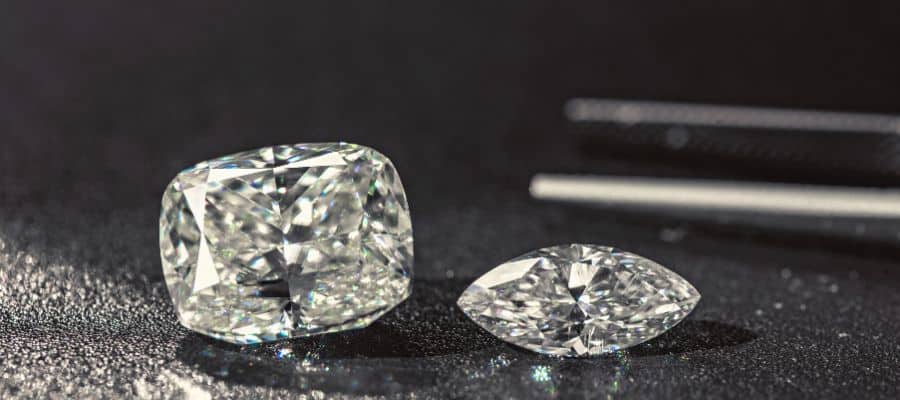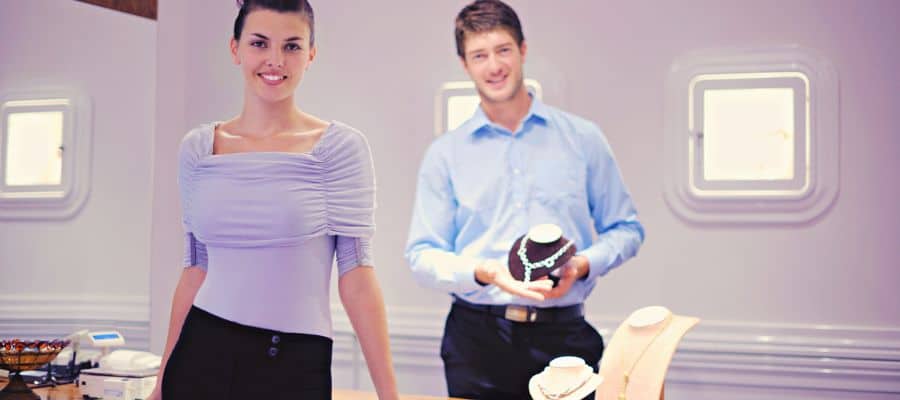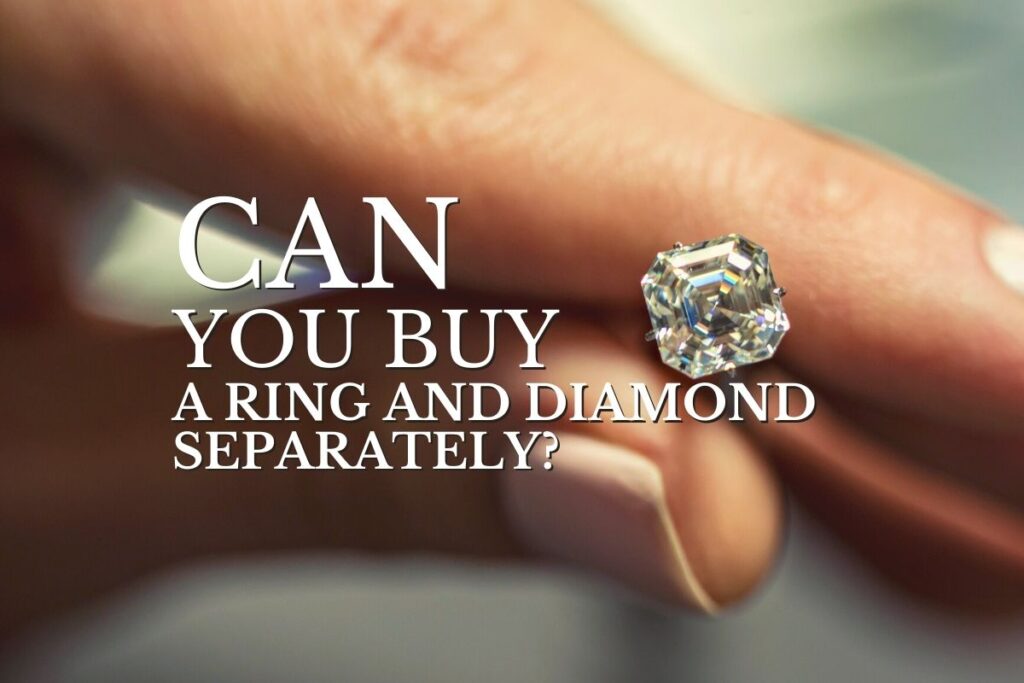Choosing a diamond ring can feel overwhelming, especially when presented with an endless array of models, cuts, and colors, all accompanied by a hefty price tag. That’s why, for many, the idea of simply going to a local jeweler, picking out one of the models on display, and calling it a day might seem like the way to go. However, there’s a better, more cost-efficient way to get your loved one something truly unique.
You can buy a ring and a diamond separately. In terms of cost-effectiveness and quality, purchasing each component separately might be better than getting a pre-made ring. Moreover, you’ll get a piece that’s personalized and tailored to your loved one’s taste.
While buying a pre-mounted diamond might be handy in a pinch, getting the ring and diamond separately is usually a better, more cost-efficient choice. Below, I’ll expand on why you not only can but should consider choosing the band and diamond separately. I’ll also take you through some of the drawbacks of this approach, along with tips on what to look for in a loose diamond.
Benefits of Buying a Ring and Diamond Separately

Shopping for a band and diamond separately might sound (and often is) an effort and time-consuming. However, it’s still the best approach to choosing a ring for the person you love. Here’s why:
You Can Customize the Ring To Fit Your Loved One’s Preferences
When shopping for an already-mounted ring, many find themselves in a situation where they like the diamond but not the band, and vice versa. In many cases, the choice becomes too much, and people end up settling for a ring neither they nor the person they’re shopping for truly loves.
On the flip side, when choosing the components separately, you have an endless array of options. You can choose the exact diamond you want, down to its clarity, color, and size, and mount it to a band that you love just as much.
Now, having to match the two components can add to the overwhelming feeling that naturally comes with ring buying. But as long as you keep your loved one’s style in mind and follow the tips outlined at the end of this article, you’ll have no trouble finding the perfect stone.
Pro-tip: Try using the same supplier for the ring and band. While this isn’t a must, knowing that both components are made from the same hands can save you time in figuring out whether the materials will match or not. Some jewelers will even recommend the pairings that go best together, so you can rest assured that the final product will be aesthetically pleasing.
Moreover, you might score some type of discount or have the mounting done for free if you use the same supplier for the diamond and the band, so this is an approach worth considering.
Altogether, you’ll often find that the extra effort is worth it when you’re able to gift your loved one something that truly fits their preferences and style. Plus, the uniqueness of the piece will add an extra layer of value, which you won’t find in mass-produced models.
You’ll Get the Best Value for Your Money
While all diamond rings are expensive, you might not know that the price of pre-mounted ones is extremely inflated (yes, even by diamond ring standards).
There are many reasons contributing to this price jump. One of the main ones is that most people prefer to stick to the traditional ring shopping process and don’t bother to take the time to customize their own (many aren’t even aware that this is a possibility).
And since sellers are selling a product that can be gifted at a moment’s notice, they monetize the convenience they offer by slapping an insane price tag on the ring. Even though the mounting process takes time and effort, if you were to add the labor costs of a separately bought diamond and ring, the final price still wouldn’t come close to that of a ready-to-use ring.
This concept might not be new to you. After all, companies like Ikea follow a similar cost strategy to keep their prices competitive.
However, here’s what might surprise you: when you buy Ikea furniture, you expect some quality to decrease along with the price. But when it comes to non-mounted rings, this isn’t the case at all. In fact, you might be able to get a better-quality diamond for your budget if you choose to buy it separately.
How can this be? Well, for starters, since the overall ring will be cheaper, you’ll be able to invest in a higher-quality diamond.
Additionally, given that the demand for loose diamonds is far lower than that for pre-made diamond jewelry, you’ll find that the same exact model, carat, and clarity level diamond will cost far less in its loose form (even when you account for the cost of other materials in the pre-made pieces).
You’ll also get better price transparency on your ring. When buying a pre-made piece of jewelry, you’re often left wondering where the mind-blowing price tag came from. However, when getting each component separately, you’ll know exactly how much you spent on the diamond, how much on the band, and how much to get the whole thing put together.
You Can Inspect the Diamond Better Before Getting It Mounted
Not only will you get a better-quality diamond for the same price, but you’ll also have the opportunity to verify its carat and clarity level. When the stone is already mounted, certain areas are simply impossible to view, and it’ll be harder for a jeweler evaluating it to move it around and inspect it like they’d probably want to.
You can easily take a loose diamond for an inspection (preferably in an establishment different from the one you purchased it from) to get a true 360° evaluation, as the whole surface will be visible.
Furthermore, if the diamond in a pre-mounted ring is cut in an unusual shape, like a heart and arrow, it might be impossible to get a reliable evaluation of its cut precision. This means you’ll be making the purchase half-blind, taking the jeweler at their word.
Another tip I can give you before diving into the “What to look for in a loose diamond” section of this article is that you should always choose the diamond first and then find a band to match, not the other way around. The stone is the ring’s central (and most expensive) component, so it’s crucial that you get it right.
Also, remember that some diamond shapes aren’t compatible with all types of bands, so consult a professional before committing to any of these components.
It’s Easier To Make Alterations
This is an often overlooked yet crucial factor that should affect your ring purchase.
You’re buying an investment piece that will hopefully be used for decades to come (some even get passed down from generation to generation). Therefore, you must ensure that the ring can be altered without affecting its structural integrity and value.
Luckily, if the person you love wants to add more of their style to the piece or prefers to change its look over the years, they can easily do so if the components were purchased separately and then mounted.
Drawbacks of Buying a Ring and Diamond Separately

Buying a ring and diamond separately does come with its drawbacks. After all, there’s a reason why so many opt to go the traditional ring-buying route and choose a pre-made piece. Let’s discuss these drawbacks below:
It Isn’t Convenient
Shopping for a ring isn’t as fun or easy as the movies make it out to be. The whole ordeal can be overwhelming, stressful, and downright nerve-racking. And opening yourself to millions of additional choices and combinations isn’t going to make it any easier.
You’ll have to spend way more time and effort searching for the perfect ring. And if you don’t have a knack for jewelry design, matching a band to a diamond might be impossible.
After all, you can’t expect the process of finding a customized, cost-effective ring to be easy.
So, if you’re not the creative type, and aren’t concerned about any additional costs you might incur, then choosing the diamond and band separately might not be the way to go.
It Isn’t Time-Effective
We’d love to spend weeks, if not months, to find that perfect ring for our perfect person; unfortunately, that’s not always feasible.
Whether you’re in a rush to gift the piece you’re after or simply can’t make enough time for jewelry shopping, buying a pre-mounted gift will take some of the stress out of ring shopping.
Plus, you can easily pick a model and already see how well the band looks with the ring. If you were to choose those components separately, you’d have to have several extensive conversations with professionals just to make sure the two actually go together.
What To Look For in a Loose Diamond
If you’ve decided that buying the diamond and band separately is worth the effort, it’s time to learn more about what to look for in a loose diamond. After all, the whole purpose of this approach is to find the best quality diamond you can afford.
Here are some of the factors you’ll want to remember when shopping for a loose diamond:
- A verifiable certificate. If you’re buying the stone from a reputable jeweler, it should come equipped with a certificate outlining its specifications. Ideally, you’d want the document to be issued by the Gemological Institute of America (GIA). However, certifications from HRD Antwerp, the International Gemological Institute (IGI), and EGL Gemological Laboratory are more than sufficient.
- An inscription. While this isn’t always a must, an ID number inscribed in the diamond speaks volumes about its quality. That’s because you’ll be able to trace back its origins and specifications, which you don’t often get to do with cheaper stones.
- Carat. Carat is one of the most well-known metrics of diamond evaluation. The metric itself refers to the size of the stone — the bigger the carat, the bigger the diamond. However, carat size isn’t always equated to a piece’s value. For example, bigger diamonds of poorer qualities will show far more imperfections than a lower-carat counterpart.
- Clarity. This is a metric that describes the quality of the diamond you’re looking at. It refers to the absence of imperfections and blemishes both on the diamond’s surface and its interior. If your budget constraints you to a low-clarity stone, at least make sure that the imperfections aren’t visible to the naked eye.
- Cut. The way a diamond is cut directly affects its quality, which is why you’ll want to opt for a stone that scores at least “Good” in this metric. A bad cut can devalue even the highest-carat, highest-clarity stone.
- Color. You want your diamonds to be colorless. The cheaper the stone, the lower its color grade will be, and the more yellow it will look.
- Symmetry. This directly relates to a diamond’s cut. When the stone isn’t cut symmetrically, it will affect the piece’s overall look, which is why you’ll want to check the “Symmetry” grading in the diamond’s certificate.
- A classic look. If you’re not entirely sure what model your loved one would like best, go classic. You’re buying a piece of jewelry that’s supposed to be worn for decades, if not more. Stay away from trendy models and stick to traditional, classic colors and shapes.
Conclusion
Ultimately, the choice of whether to buy the diamond and ring separately or together is a personal one. That’s why the right approach can vary depending on your preferences and circumstances.
However, getting a loose diamond and mounting it onto a band of your choice is the generally better, more cost-efficient choice. Doing so allows you to customize the ring and tailor it to your loved one’s preferences. It also makes it easier for you to determine the quality and clarity of the diamond, all while keeping costs down.
If you found this article useful, make sure you save this pin below to your Jewelry board.


